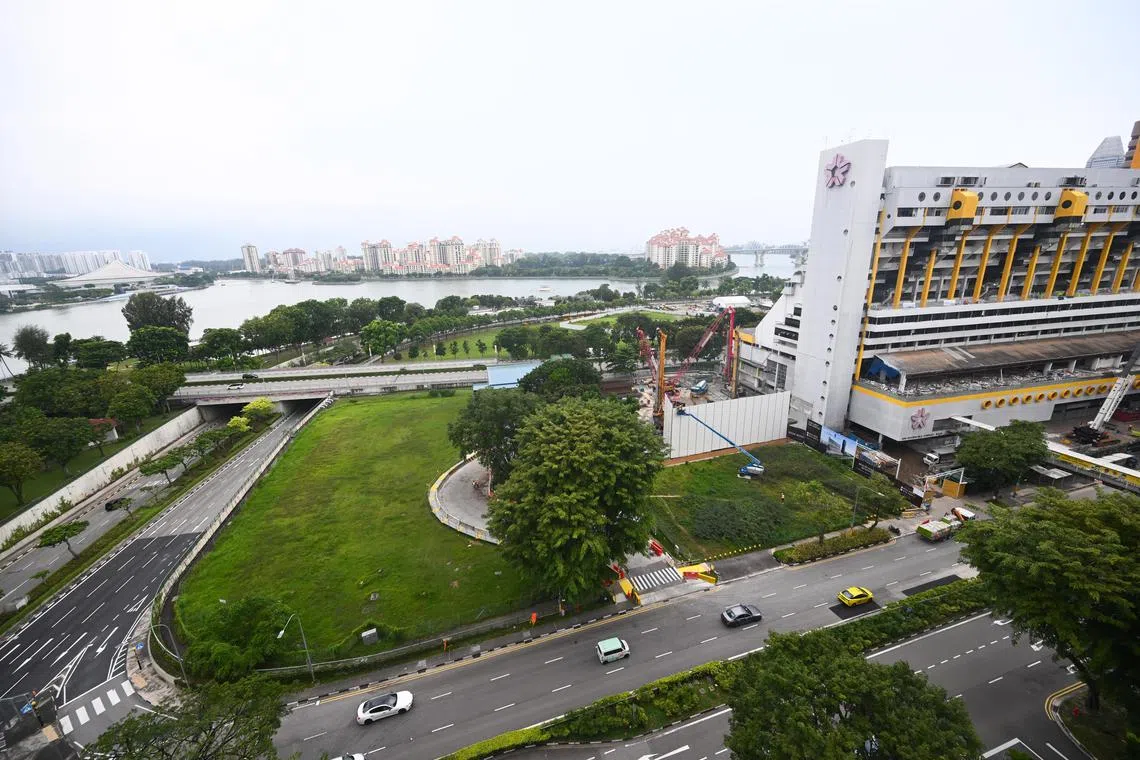URA redraws development plans for upcoming 4,000-home Kampong Bugis precinct
Sign up now: Get ST's newsletters delivered to your inbox

Soil treatment works at Kampong Bugis, which began in 2020, are still ongoing.
ST PHOTO: AZMI ATHNI
Follow topic:
SINGAPORE – The authorities have redrawn development plans for Kampong Bugis, where an estimated 4,000 waterfront homes will be built.
The precinct is among several upcoming neighbourhoods along the Kallang River that are being showcased at the Urban Redevelopment Authority’s (URA) Draft Master Plan 2025 exhibition
In total, land set aside for housing along the river is expected to yield thousands of new homes in areas such as Kallang Distripark, Kallang Industrial Estate and Tanjong Rhu.
These homes will build on recent efforts to have more Singaporeans live closer to the city centre, and also renew older Housing Board estates such as Geylang Bahru and North Bridge Road, which date back to the 1970s.
The adjusted plans for Kampong Bugis are notable as an 8.2ha portion of the 17ha site was previously put on sale in 2019 soil treatment works
The 8.2ha site that was up for sale contained four plots that were zoned as white sites, or sites meant for mixed-used developments.
But based on URA’s 2025 draft masterplan, only two of these four plots remain. The other two have had their boundaries redrawn and been rezoned, with one split into two residential plots with a new road that will divide them, and the other now meant primarily for homes, with commercial uses on its first storey.

When URA launched the site for sale in 2019, its intention was for a master developer to purchase, masterplan and develop the four plots, which the agency said could hold up to 4,000 private homes and an additional 50,000 sq m of space for ancillary uses such as retail. This was to be completed over 11 to 13 years.
How these homes and complementary uses would be distributed across the four plots was for the developer to propose – an approach that could achieve better integration between Kampong Bugis’ developments, compared with if individual developers were to develop each of the four plots.
Asked if Kampong Bugis will still be sold to a master developer, the URA said agencies are reviewing plans for the four plots that made up the 8.2ha site previously put on sale, adding that there are still plans for the precinct to have about 4,000 new waterfront homes.
The agency added that in response to industry feedback, the Government will “undertake the necessary land preparation and infrastructure works, such as introducing a new road and utilities network, to support the development of Kampong Bugis”. Such tasks were initially the responsibility of the master developer when the site was on sale.
Savills Singapore’s executive director of research and consultancy Alan Cheong said given present market conditions and cooling measures, developers consider the master developer approach risky.
“Master developer sites could still get traction if the market, despite the cooling measures, is hot. However, these days, if market activity is too hyped up, the risk of further cooling measures would rein in developers’ enthusiasm,” said Mr Cheong.
A bid for a 6.5ha master developer site in Jurong Lake District – the last master developer site to be put up for sale – was rejected by the authorities
Comparing this site with Kampong Bugis, Mr Cheong said that Kampong Bugis has better selling attributes, especially its location in central Singapore.
However, he said that with the current cooling measures in place, a more piecemeal approach – where developers bid for and develop individual, smaller plots of land – will help developers mitigate financial risks.
In contrast, chief research officer at property search portal Mogul.sg Nicholas Mak said the master developer approach for Kampong Bugis could still be tenable given the area’s central location and likelihood of high market demand.
He noted that this approach also puts less strain on public resources, as the Government will not have to finance as much development work.
Soil remediation works for Kampong Bugis began in February 2020 and are still ongoing. When asked, the Singapore Land Authority – which is overseeing the works – and URA did not say when this will be completed.
Near the upcoming precinct, the draft masterplan also shows a new housing plot next to Aurea, a condominium being built beside the conserved Golden Mile Complex

A 0.8ha plot of land next to Golden Mile Complex and Aurea (under construction) has been earmarked in the draft masterplan for housing.
ST PHOTO: AZMI ATHNI
The plot is about 0.8ha in size and is near Nicoll, an upcoming mixed-use precinct.
Apart from Kampong Bugis, several other areas have been earmarked for new homes near the Kallang River, in addition to an upcoming lifestyle hub centred on the Old Kallang Airport.
These include about 6ha of land in Tanjong Rhu that analysts said can yield about 2,000 private homes and about 34ha of land in Marina East near the upcoming Founders’ Memorial in Bay East Garden.
In its exhibition, URA said developments along Kallang River “will be guided to provide greenery fronting the river”, such as through sky and roof terraces.
These new developments also offer opportunities to inject vibrancy along the identity corridor, said URA, by having new developments incorporate retail and dining spaces by the riverfront.
Old Kallang Airport
The agency said it plans to “introduce mixed uses that incorporate lifestyle and recreational elements
Near the former airport, which is currently vacant, there are six plots of land zoned for hotel use, and several other plots set aside for commercial and mixed uses.

The authorities plan to establish a mixed-use lifestyle hub centred on the Old Kallang Airport.
ST PHOTO: LIM YAOHUI
Mr Cheong said that the former airport’s proximity to the Singapore Sports Hub in the Kallang Alive precinct makes it suitable for lifestyle uses, adding that the site could also be used for high-rise office towers with waterfront views.
He noted that the area also has a relatively laid-back atmosphere, which suits hotel developments.
Kallang Distripark
There are also longstanding plans to develop Kallang Distripark
According to the draft masterplan, about 12ha of land can be developed for housing in Kallang Distripark, a privately owned disused rubber factory converted into a warehouse.

The privately-owned Kallang Distripark, a former rubber factory, is slated to be a waterfront residential neighbourhood.
ST PHOTO: NG KENG GENE
Based on parameters in the draft masterplan, Mr Mak said the site can yield about 2,500 flats, or about 3,200 private apartments. He said the future neighbourhood is an attractive housing site given its proximity to the Central Business District.
Asked about Kallang Distripark’s redevelopment timeline, URA said “plans will be reviewed in due time”. A portion of the site is freehold, while part of it is on a 99-year lease that expires in 2067. The neighbouring 6ha Geylang Bahru Industrial Estate – located next to Geylang Bahru MRT station – is on a 99-year lease that expires in the mid-2070s.

Geylang Bahru Industrial Estate is managed by JTC Corporation and is located next to Geylang Bahru MRT station.
ST PHOTO: NG KENG GENE
Also slated for redevelopment into new homes is Kallang Basin Swimming Complex, which closed on Aug 31


